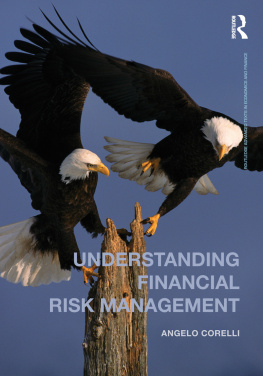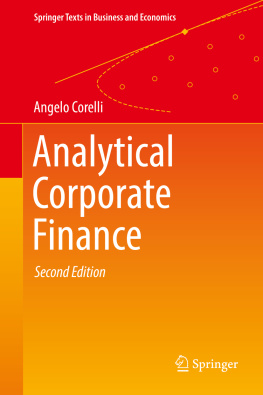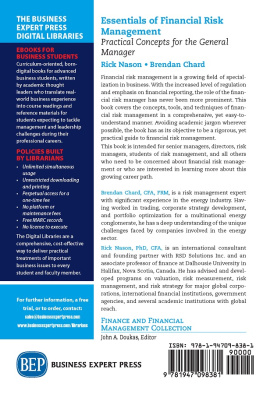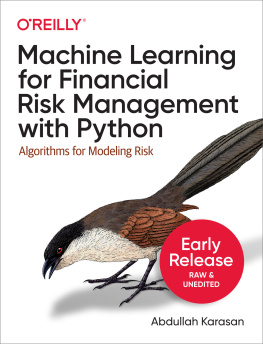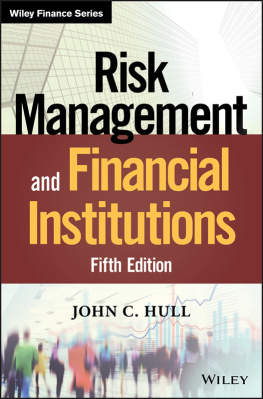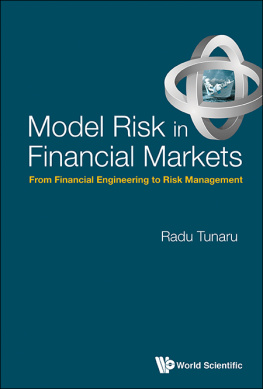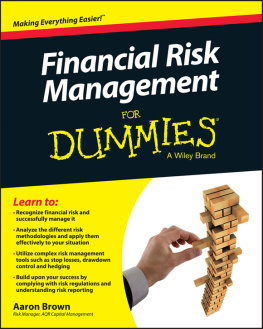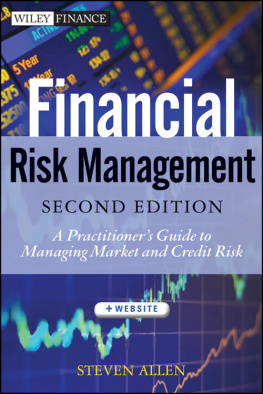
Understanding Financial Risk Management
Financial risk management is a topic of primary importance in financial markets and, more generally, in life. Risk can be seen as an opportunity if related to the concept of compensative return. It is therefore important to learn how to measure and control risk, in order to get exposure to as much risk as is necessary to achieve some level of compensation, without further useless exposure.
This book analyses the various types of financial risk a financial institution faces in everyday operations. Each type of risk is dealt with using a rigorous mix of analytical and theoretical approaches, describing all the major models available in the literature, with an innovative look at the topic.
This book covers the following aspects of risk and provides introductory overviews of the most relevant statistical and mathematical tools:
market risk
interest rate risk
credit risk
liquidity risk
operational risk
currency risk
volatility risk.
Understanding Financial Risk Management offers an innovative approach to financial risk management. With a broad view of theory and the industry, it aims at being a friendly, but serious, starting point for those who encounter risk management for the first time, as well as for more advanced users.
Angelo Corelli is Assistant Professor of Finance, Bursa Orhangazi University, Turkey.
Routledge Advanced Texts in Economics and Finance
1. Financial Econometrics
Peijie Wang
2. Macroeconomics for Developing Countries Second Edition
Raghbendra Jha
3. Advanced Mathematical Economics
Rakesh Vohra
4. Advanced Econometric Theory
John S. Chipman
5. Understanding Macroeconomic Theory
John M. Barron, Bradley T. Ewing and Gerald J. Lynch
6. Regional Economics
Roberta Capello
7. Mathematical Finance: Core Theory, Problems and Statistical Algorithms
Nikolai Dokuchaev
8. Applied Health Economics
Andrew M. Jones, Nigel Rice, Teresa Bago dUva and Silvia Balia
9. Information Economics
Urs Birchler and Monika Btler
10. Financial Econometrics Second Edition
Peijie Wang
11. Development Finance Debates, Dogmas and New Directions
Stephen Spratt
12. Culture and Economics On Values, Economics and International Business
Eelke de Jong
13. Modern Public Economics Second Edition
Raghbendra Jha
14. Introduction to Estimating Economic Models
Atsushi Maki
15. Advanced Econometric Theory
John Chipman
16. Behavioral Economics
Edward Cartwright
17. Essentials of Advanced Macroeconomic Theory
Ola Olsson
18. Behavioral Economics and Finance
Michelle Baddeley
19. Applied Health Economics Second Edition
Andrew M. Jones, Nigel Rice, Teresa Bago dUva and Silvia Balia
20. Real Estate Economics A Point to Point Handbook
Nicholas G. Pirounakis
21. Finance in Asia Institutions, Regulation and Policy
Qiao Liu, Paul Lejot and Douglas Arner
22. Behavioral Economics Second Edition
Edward Cartwright
23. Understanding Financial Risk Management
Angelo Corelli
Understanding Financial Risk Management
Angelo Corelli

First published 2015
by Routledge
2 Park Square, Milton Park, Abingdon, Oxon, OX14 4RN
and by Routledge
711 Third Avenue, New York, NY 10017
Routledge is an imprint of the Taylor & Francis Group, an informa business
2015 Angelo Corelli
The right of Angelo Corelli to be identified as author of this work has been asserted by him in accordance with the Copyright, Designs and Patent Act 1988.
All rights reserved. No part of this book may be reprinted or reproduced or utilised in any form or by any electronic, mechanical, or other means, now known or hereafter invented, including photocopying and recording, or in any information storage or retrieval system, without permission in writing from the publishers.
Trademark notice: Product or corporate names may be trademarks or registered trademarks, and are used only for identification and explanation without intent to infringe.
British Library Cataloguing in Publication Data
A catalogue record for this book is available from the British Library
Library of Congress Cataloguing in Publication data
Corelli, Angelo.
Understanding financial risk management / Angelo Corelli.
pages cm. (Routledge advanced texts in economics and finance) Includes bibliographical references and index.
1. Financial risk management. 2. Risk management. I. Title.
HD61.C668 2014
658.155dc23
2014008863
ISBN: 978-0-415-74617-5 (hbk)
ISBN: 978-1-315-79753-3 (ebk)
ISBN: 978-0-415-74618-2 (pbk)
Typeset in Times New Roman
by Out of House Publishing
Alla mia famiglia
Giuseppe,
Rina,
e Mauro
Contents
A modern approach
Understanding Financial Risk Management offers an innovative approach to financial risk management. With a broad view of theory and the industry, it aims at being a friendly, but serious, starting point for those who encounter risk management for the first time, as well as for more advanced users.
The focus is no longer on the mere measurement, but on the whole package. Risk is also opportunity, and when managing it, one should reach the right balance between opportunity and loss. That is why we propose a new approach that starts from the basic knowledge of classic theory and methodologies and moves to the latest findings in measurement and hedging.
Many books are more exhaustive in covering some of the topics that are treated in this book, but most of them do not offer the wholesome coverage on the horizon of financial risk management as the present book does.
There is no doubt that a deeper analysis of many concepts is possible, but no book in the actual market is able to collect all risks and the managing of them in one single essay. This book is definitely an all-included piece or work that guides the reader from the beginning to the end without ever losing focus on what is more important for good risk management knowledge.
An innovative pedagogy
The foundations of the book rely on three main blocks: theory, analytics and computational. They all merge in a way that makes it easy for students to understand the exact meaning of the concepts and their representation and applicability in real-world contexts. Examples are given throughout the chapters in order to clarify the most intricate aspects; where needed, there are appendices at the end of chapters that give more mathematical insights about specific topics.
Learning comes from the correct combination of the three pillar elements, none of which should be excluded. The trinity stands as the foundation of the whole project.
Preferably, students have a solid background in financial mathematics, statistics and basic econometrics. Indeed, students facing financial topics for the first time may benefit from using the book as a medium-level introduction to some aspects of financial theory and practice.
Next page
